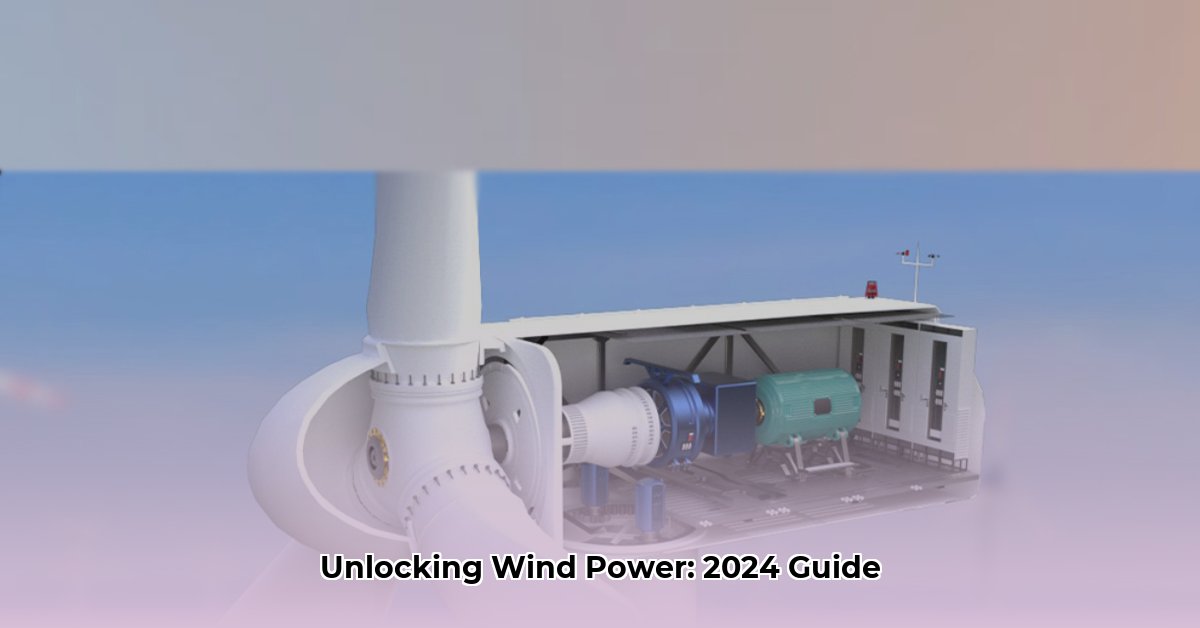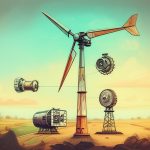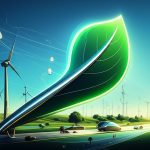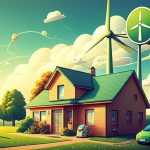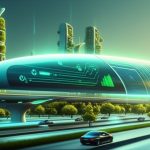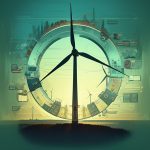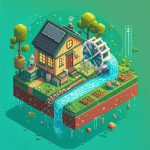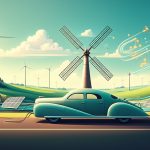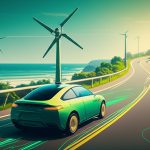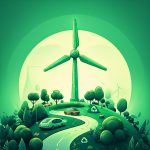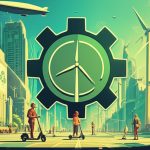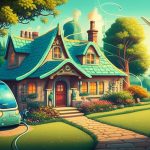Wind turbines are transforming our energy landscape. This 2024 guide explores the intricacies of these powerful machines, from their basic mechanics to cutting-edge innovations. Whether you’re a novice or an expert, discover the science, technology, and future of wind power.
How Wind Turbines Work
From Breeze to Electricity
Wind turbines operate on a simple principle: converting wind’s kinetic energy into electricity. Aerodynamically designed blades, similar to airplane wings, capture the wind, creating a pressure difference that causes them to rotate. This rotation spins a rotor connected to a drive shaft, which extends into the nacelle—the housing at the top of the turbine. Inside the nacelle, a generator, often coupled with a gearbox to increase rotational speed, transforms the mechanical energy into electrical energy. This electricity then flows through a step-up transformer to increase voltage for efficient transmission via power lines to homes and businesses.
Types of Wind Turbines
Horizontal-Axis Wind Turbines (HAWTs)
HAWTs are the most common type, dominating wind farms worldwide. Their rotors, typically with three blades, face into the wind, maximizing energy capture. These turbines are highly efficient, approaching the theoretical Betz Limit of 59%, and often reaching 45% in practice. However, they require yaw systems to track wind direction, can be visually imposing, generate some noise, and pose a risk to wildlife.
Vertical-Axis Wind Turbines (VAWTs)
VAWTs, resembling giant eggbeaters, offer a different approach. Their vertical axis allows them to capture wind from any direction, eliminating the need for yaw systems. They are quieter, have a smaller visual footprint, and potentially pose less of a threat to birds and bats. However, VAWTs are generally less efficient than HAWTs, particularly at larger scales, and face engineering challenges for large-scale deployment. Two primary VAWT designs exist: Savonius (drag-based) and Darrieus (lift-based).
| Feature | HAWT | VAWT |
|---|---|---|
| Axis Orientation | Horizontal | Vertical |
| Wind Direction | Tracks the wind | Omnidirectional |
| Efficiency | Higher (up to 45%) | Lower (up to 35% for Darrieus, 15% for Savonius) |
| Size | Scalable to large sizes | Challenging to scale up |
| Noise | Can be louder | Quieter |
| Maintenance | More complex | Simpler |
Emerging Turbine Technologies
Beyond HAWTs and VAWTs, innovative designs are emerging, including:
- Airborne Wind Energy Systems (AWES): Tethered kites or drones capture high-altitude winds, potentially accessing stronger and more consistent wind resources. Companies like Makani and Altaeros are pioneering these technologies.
- Bladeless Turbines: Companies like Vortex Bladeless are developing turbines that use oscillation rather than rotation to generate electricity, reducing noise and visual impact.
Environmental and Economic Impacts
Environmental Considerations
Wind energy offers significant environmental benefits, but also presents challenges:
Pros:
- Clean Energy Source: Wind power produces no greenhouse gas emissions during operation.
- Reduced Fossil Fuel Dependence: Wind energy diversifies energy sources, lessening reliance on fossil fuels.
- Renewable Resource: Wind is a naturally replenished resource.
Cons:
- Wildlife Impacts: Bird and bat collisions and barotrauma are concerns, though mitigation strategies like quieter turbines and strategic placement are being developed. Ongoing research explores ways to improve turbine visibility for wildlife.
- Noise Pollution: While modern turbines are quieter, noise can still affect nearby residents. Research into noise reduction continues. Sound-absorbing materials and increased setback distances are common mitigation strategies.
- Visual Impact: The visual impact of wind turbines on landscapes remains a concern. Careful siting and community engagement are vital.
- Habitat Alteration: Wind farms can alter habitats. Minimizing land use and careful site selection are crucial. Long-term ecological studies are needed to fully understand these impacts.
- Manufacturing and Disposal: Producing and disposing of turbine components have environmental impacts, though less significant than fossil fuel infrastructure. Research focuses on sustainable materials and improved recycling methods.
Economic Considerations
Wind energy offers economic advantages but also presents some challenges:
Pros:
- Job Creation: The wind industry creates jobs in manufacturing, installation, maintenance, and research.
- Local Economic Benefits: Land lease payments and tax revenues benefit local communities.
- Lower Energy Costs: Wind power can contribute to lower electricity prices for consumers.
- Energy Security: Increased wind power reduces dependence on volatile global energy markets.
Cons:
- High Initial Investment: Wind farms require significant upfront capital. Government incentives and innovative financing models can help address this.
- Potential Property Value Impacts: Concerns exist about the effect of wind farms on nearby property values. Transparent communication with communities and thorough planning are important. Further research is needed to fully understand these effects.
- Intermittency Challenges: Wind power is intermittent, requiring energy storage solutions like batteries or backup generation sources to maintain grid stability. Advancements in energy storage technologies are ongoing.
The Future of Wind Energy
The wind energy sector is constantly evolving. Innovations are driving greater efficiency, reducing costs, and addressing environmental concerns. Key areas of development include:
- Larger and More Efficient Turbines: Turbines are growing larger, with longer blades and more powerful generators, maximizing energy capture. Advanced materials and aerodynamic designs further enhance performance.
- Floating Offshore Wind Farms: These farms unlock the potential of deep-water sites with stronger and more consistent winds.
- Smart Grid Integration: Integrating wind power with smart grids optimizes energy distribution and management, addressing intermittency challenges.
- Advanced Energy Storage: Improved battery technology and other storage solutions are crucial for balancing intermittent wind power and ensuring grid reliability.
- Hybrid Projects: Combining wind power with other renewable sources like solar or hydropower creates more resilient and efficient energy systems.
- Multipurpose Offshore Platforms: Integrating desalination plants or green hydrogen production facilities with offshore wind farms maximizes resource utilization.
The future of wind energy is bright, driven by technological advancements, policy support, and growing public awareness of the need for clean energy solutions. While challenges remain, wind power is poised to play an increasingly vital role in the global transition to a sustainable energy future.
- How To Make Electricity At Home With Water Using DIY Micro-Hydro - December 7, 2025
- How to Generate Electricity from Water at Home for Off-Grid Power - December 6, 2025
- Small Scale Hydropower Brings Sustainable Energy to Rural Areas - December 5, 2025
